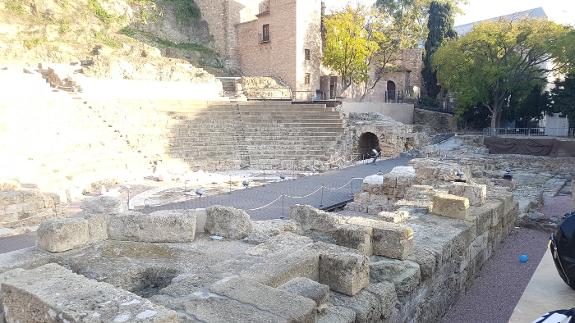

Sections
Highlight

JESÚS HINOJOSA
Tuesday, 23 April 2019, 18:07
Compartir
Few cities can boast of being able to show visitors a Roman theatre at the side of a construction which dates back to Moorish times, but Malaga can. This area of the city is one of the most-photographed by tourists, but it has only been on display for the past 20 years, since the information centre was created.
That was the last time there were major plans for these important remains, but now it looks as if the restoration of the Roman theatre, one of the city's principal attractions is to continue. The monument first came to light in 1951, discovered when a containing wall was being built on the site of the Casa de la Cultura (which no longer exists), beside the Alcazaba fortress.
The Junta de Andalucía's Ministry of Culture, through the Historic Heritage Committee of Malaga, has now given the green light to a new project which the regional government had been planning for several years but has not yet been put into effect. It involves restoring the 'orchestra' and the front of the stage, and six years ago the cost was estimated to cost about 400,000 euros. The plans also included improving two areas of the theatre which are closest to the wooden stage, which is used for performances occasionally throughout the year.
The 'orchestra' is the paved semi-circular area between the stands and the stage, and the plans also include repairing the 'frons pulpitum', the front part of the stage.
Pedro Rodríguez Oliva, professor of Archaeology at Malaga university, knows the Roman theatre well because he played an active part in recovering it after the Casa de la Cultura was demolished; he says the 'orchestra' has deteriorated because originally it was covered by marble which, when the theatre fell into disuse, was pulled up and used for the production of lime.
For its part, the 'frons pulpitum' has an irregular shape with different entrances and exits, and is not in a straight line. There are also the remains of some small troughs which may originally have been fountains to decorate the front part of the stage where the theatre performances used to take place. Between the front of the stage and the 'orchestra', traces of an inscription from the time of the Flavians have been discovered.
Recuperation
"The work which has been carried out so far by the Junta at the Roman theatre has been very respectful of the monument, so I imagine that this will be too," says Rodríguez Oliva, who explains that the next stage of the restoration of the theatre should be carried out on the stands closest to the Albéniz cinema. Their appearance could be improved with the original ashlars which are still piled up in the highest part of the coliseum and could be used for the reconstruction.
In the meantime, the Provincial Heritage Committee has also given the go-ahead to a project from the regional government's Andalusian Agency for Cultural Institutions to improve the itinerary for visits to the Roman theatre. This will consist of remodelling the interior of the visitors' information centre, and improving the outside area, where broken sections of the walkway will be replaced, the balustrades will be repaired and panels of anti-reflective laminated glass will be placed on the viewing platform (similar to those which already exist beside Calle Alcazabilla) as a safety feature to prevent pedestrians falling.
The regional government's Ministry of Culture, which is currently represented in Malaga province by Carmen Casero, has invested over four million euros on different projects at the Roman theatre The theatre is believed to date back to the first century, during the time of Emperor Augustus, and its definitive restoration began in 1995, when the work began to demolish the Casa de la Cultura.
Publicidad
Publicidad
Publicidad
Publicidad
Reporta un error en esta noticia
Necesitas ser suscriptor para poder votar.